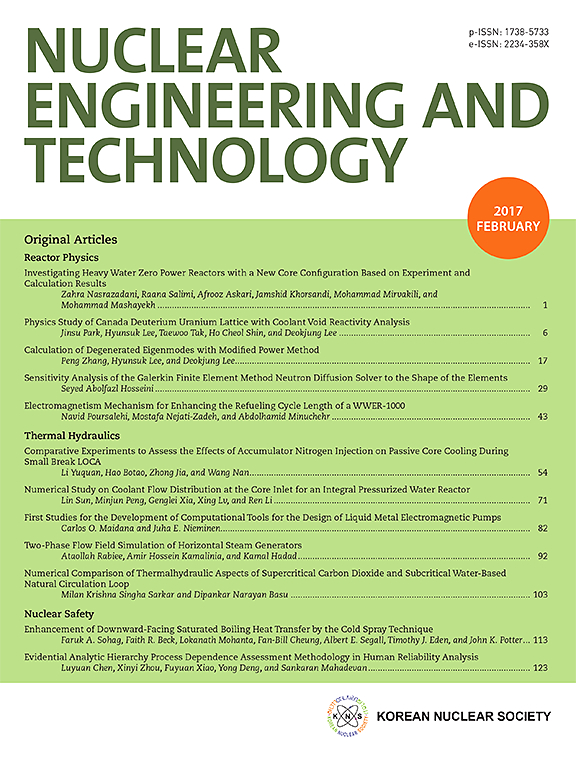Numerical modeling and characteristic analysis of the pneumatic noise of spring-loaded pressure relief valves
IF 2.6
3区 工程技术
Q1 NUCLEAR SCIENCE & TECHNOLOGY
引用次数: 0
Abstract
High-intensity turbulence and interactions among multiple structural parameters are the main factors hindering effective noise prediction in spring-loaded pressure relief valve (SLPRV). On this basis, an in-depth numerical modeling and mechanism analysis are carried out in this paper, where the Computational Fluid Dynamics (CFD) method and Computational Air Acoustic (CAA) are implemented to analysis the noise characteristics of the transient flow field when gas flows through the valve,on this basis, the attenuation characteristics and directivity of the noise were analyzed. In addition, a noise experimental platform for the SLPRV and an acoustic acquisition matrix were set up to verify the accuracy of the simulation results. In order to accurately predict its noise directivity, three key parameters at the valve orifice were selected for research, and a Kriging high-fidelity surrogate model (KHFSM) of the valve structure and noise directivity was constructed. The results show that, under different key structures of the valve, the determination coefficient R2 of the noise predicted by KHFSM reaches 0.969, and the maximum error is less than 1 dB, it can accurately predict the noise directivity of SLPRV, and establish a theoretical and methodological framework underpinning the acoustic optimization of safety valves in nuclear power systems.
弹簧式减压阀气动噪声数值模拟及特性分析
高强度湍流和多结构参数之间的相互作用是影响弹簧减压阀有效噪声预测的主要因素。在此基础上,本文进行了深入的数值模拟和机理分析,采用计算流体力学(CFD)方法和计算空气声学(CAA)方法对气体流经阀门时瞬态流场的噪声特性进行了分析,在此基础上分析了噪声的衰减特性和指向性。此外,建立了SLPRV噪声实验平台和声学采集矩阵,验证了仿真结果的准确性。为了准确预测其噪声指向性,选取阀口处的3个关键参数进行研究,构建了阀结构与噪声指向性的Kriging高保真代理模型(KHFSM)。结果表明,在阀门不同关键结构下,KHFSM预测噪声的决定系数R2达到0.969,最大误差小于1 dB,能够准确预测SLPRV的噪声指向性,为核电系统安全阀声学优化建立了理论和方法框架。
本文章由计算机程序翻译,如有差异,请以英文原文为准。
求助全文
约1分钟内获得全文
求助全文
来源期刊

Nuclear Engineering and Technology
工程技术-核科学技术
CiteScore
4.80
自引率
7.40%
发文量
431
审稿时长
3.5 months
期刊介绍:
Nuclear Engineering and Technology (NET), an international journal of the Korean Nuclear Society (KNS), publishes peer-reviewed papers on original research, ideas and developments in all areas of the field of nuclear science and technology. NET bimonthly publishes original articles, reviews, and technical notes. The journal is listed in the Science Citation Index Expanded (SCIE) of Thomson Reuters.
NET covers all fields for peaceful utilization of nuclear energy and radiation as follows:
1) Reactor Physics
2) Thermal Hydraulics
3) Nuclear Safety
4) Nuclear I&C
5) Nuclear Physics, Fusion, and Laser Technology
6) Nuclear Fuel Cycle and Radioactive Waste Management
7) Nuclear Fuel and Reactor Materials
8) Radiation Application
9) Radiation Protection
10) Nuclear Structural Analysis and Plant Management & Maintenance
11) Nuclear Policy, Economics, and Human Resource Development
 求助内容:
求助内容: 应助结果提醒方式:
应助结果提醒方式:


